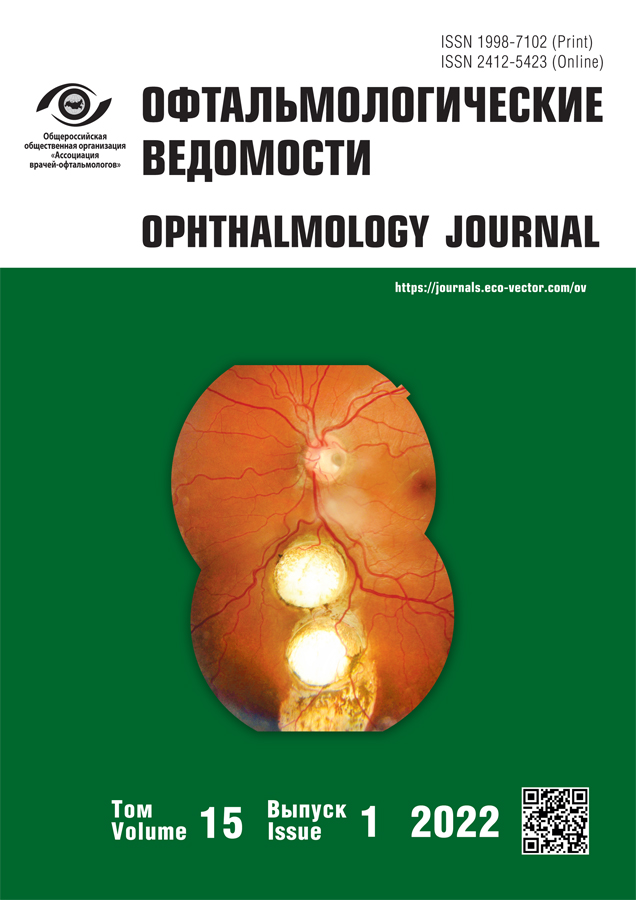The acute necrotizing periorbital fasciitis. Clinical case
- Authors: Haritonova N.N.1, Gorbachev D.S.1, Safonov M.S.2, Kolbin A.A.1, Kulikov A.N.1, Kolke A.A.2, Batyrshin I.M.2, Zinoviev E.V.2
-
Affiliations:
- S.M. Kirov Military Medical Academy
- I.I. Dzhanelidze St. Petersburg Scientific Research Institute of Ambulance
- Issue: Vol 15, No 1 (2022)
- Pages: 69-76
- Section: Case reports
- Submitted: 02.02.2022
- Accepted: 29.03.2022
- Published: 10.06.2022
- URL: https://journals.eco-vector.com/ov/article/view/100108
- DOI: https://doi.org/10.17816/OV100108
- ID: 100108
Cite item
Abstract
BACKGROUND: A rare severe, characterized by high mortality in some localizations (up to 70%) necrotizing periorbital fasciitis has not been described previously in the national literature.
AIM: to show a multidisciplinary approach to the treatment and rehabilitation of patients with periorbital necrotizing fasciitis on the example of the clinical case.
CLINICAL CASE: Patient with the acute necrotizing fasciitis of both eyelids, with the dissemination to the superficial face and neck fascies, the sepsis development is given. Monitoring of vital functions, homeostasis indicators, repeated inoculations, computed tomography, regular examination by an ophthalmologist included the control of visual functions, anterior and posterior segments, closure of the eye fissure. Conservative and surgical treatment applied by a multidisciplinary team is presented, which allowed to save the patient’s life, overpass the purulent-necrotic, and then the rough scar process and to achieve satisfactory anatomical and functional results.
CONCLUSION: Timely multidisciplinary treatment of periorbital necrotizing fasciitis is necessary for the life preservation, prevention of severe complications from the eye. With the threat of developing lagophthalmos, it is necessary to perform permanent blepharoraphy for 3–6 months after the first surgery and further surgical and pharmacological correction of scarring processes.
Full Text
About the authors
Natalia N. Haritonova
S.M. Kirov Military Medical Academy
Author for correspondence.
Email: natal56@mail.ru
ORCID iD: 0000-0002-8550-7171
SPIN-code: 9277-7406
Scopus Author ID: 55047042700
ResearcherId: N-3214-2016
Cand. Sci. (Med.), Assistant Professor of the Department of Ophthalmology
Russian Federation, Saint PetersburgDmitriy S. Gorbachev
S.M. Kirov Military Medical Academy
Email: dmitrij-gor@yandex.ru
Cand. Sci. (Med.), Assistant Professor, Assistant of the Department of Ophthalmology
Russian Federation, Saint PetersburgMaksim S. Safonov
I.I. Dzhanelidze St. Petersburg Scientific Research Institute of Ambulance
Email: Safonovmaksim@mail.ru
Surgeon of the Burn Department
Russian Federation, Saint PetersburgAleksey A. Kolbin
S.M. Kirov Military Medical Academy
Email: zd97@mail.ru
SPIN-code: 4718-5171
Head of the Purulent Department of the Ophthalmology Clinic of the Department of Ophthalmology
Russian Federation, Saint PetersburgAlexey N. Kulikov
S.M. Kirov Military Medical Academy
Email: alexey.kulikov@mail.ru
ORCID iD: 0000-0002-5274-6993
SPIN-code: 6440-7706
Scopus Author ID: 57001225300
ResearcherId: M-2094-2016
Dr. Sci. (Med.), Assistant Professor, Head of the Department of Ophthalmology
Russian Federation, Saint PetersburgAlena A. Kolke
I.I. Dzhanelidze St. Petersburg Scientific Research Institute of Ambulance
Email: a.kolke@mail.ru
Plastic Surgeon of the Burn Department
Russian Federation, Saint PetersburgIldar M. Batyrshin
I.I. Dzhanelidze St. Petersburg Scientific Research Institute of Ambulance
Email: Onrush@mail.ru
Head of the Department of Surgical Infections
Russian Federation, Saint PetersburgEvgeny V. Zinoviev
I.I. Dzhanelidze St. Petersburg Scientific Research Institute of Ambulance
Email: evz@list.ru
Dr. Sci. (Med.), Professor, Chief freelance specialist-kombustiologist of the Ministry of Health
Russian Federation, Saint PetersburgReferences
- Grinev MV, Korolkov AYu, Grinev KM, Beybalaev KZ. Necrotizing fasciitis – a clinical model of the department of public health: medicine of critical state. Grekov’s Bulletin of Surgery. 2013;172(2): 32–38. (In Russ.) doi: 10.24884/0042-4625-2013-172-2-032-038
- Aliev SA, Aliev ÉS, Zeĭnalov BM. Fournie´s disease in the light of modern ideas. Pirogov Russian journal of surgery. 2014;(4):34–39. (In Russ.)
- Bellapianta JM, Ljungqist K, Tobin E, Richard U. Necrotizing fasciitis. J Am Acad Orthop Surg. 2009;17(3):174–182. doi: 10.5435/00124635-200903000-00006
- Tambe K, Tripathi A, Burns J, Sampath R.. Multidisciplinary management of periocular necrotising fasciitis: a series of 11 patients. Eye. 2012;26:463–467. doi: 10.1038/eye.2011.241
- Balaggan KS, Goolamali SI. Periorbital necrotising fasciitis after minor trauma. Graefes Arch Clin Exp Ophthalmol. 2006;244:268–270. doi: 10.1007/s00417-005-0078-4
- Herdiana TR, Takahashi Y, Valencia RP, et al. Periocular necrotizing fasciitis with toxic shock syndrome. Case Rep Ophthalmol. 2018;9(2):299–303. doi: 10.1159/000488971
- Kent D, Atkinson PL, Patel B, Davies EWG. Fatal bilateral necrotising fasciitis of the eyelids. Br J Ophthalmol. 1995;79:95–96. doi: 10.1136/bjo.79.1.95
- Shield DR, Servat J, Paul S, et al. Periocular necrotizing fasciitis causing blindness. JAMA Ophthalmol. 2013;131(9):1225–1227. doi: 10.1001/jamaophthalmol.2013.4816
- Kronish JW, McLeish WM. Eyelid necrosis and periorbital necrotizing fasciitis. Report of a case and review of the literature. Ophthalmology. 1991;98(1):92–98. doi: 10.1016/s0161-6420(91)32334-0
- Dowsett C, Ayello E. TIME principles of chronic wound bed preparation and treatment. Br J Nurs. 2004;13(15):S16–S23. doi: 10.12968/bjon.2004.13.Sup3.15546
- Kolke AA, Zinoviev EV, Zavatskii VV. Applicability of biomedical products in patients with diabetic foot syndrome. Emergency medical care. 2020;21(4):63–69. (In Russ.) doi: 10.24884/2072-6716-2020-21-4-63-69
Supplementary files

















